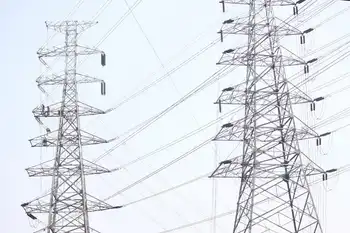Coal-fired TVA generating plant sets record for continous production
STEVENSON, ALABAMA - For the past two years, Terry Everett has been a little like the Maytag appliance repair man.
As one of the operators of the Unit 3 generator at TVA's Widows Creek Fossil Plant, Mr. Everett hasn't had to deal with any power outages on his unit for a record 737 days.
"We make our hourly meter readings and just hope it keeps running," he said.
The coal-fired unit, one of eight at this riverfront plant in North Alabama, broke the U.S. record in December for the longest continuous power production of any commercial power plant.
Tennessee Valley Authority officials said the record run is especially impressive given the age of the unit. Built in the early 1950s, the unit already has lasted a decade beyond its original 40- year accounting life.
"I can't say enough about our employees and the attention they pay to detail, processes and procedures to keep the plant running," Widows Creek Plant Manager Gerald Hemmer said.
Widows Creek and TVA's 10 other coal plants may be approaching retirement age, but the aging plants remain the workhorses for TVA's power system. During the peak demand periods last summer, TVA's fossil plants produced most of the utility's electricity and set a record for reliability with the lowest forced outage rate in history.
But for all their generating success, Widows Creek and other, older coal plants also are major polluters of the air in the Tennessee Valley, according to U.S. Environmental Protection Agency data. U.S. Sen. Lamar Alexander, R-Tenn., said Tuesday that sulfur dioxide generated from coal plants such as Widows Creek probably causes 40 percent of the smog in the Great Smoky Mountains.
"These plants also produce nitrogen pollutants and mercury, which are hazardous to our health," Sen. Alexander said. "TVA has the latest pollution control equipment on only two of the eight units at Widows Creek today. If we're really serious about clean air, TVA needs to put the latest pollution control equipment on all of its coal-fired units and/or build more nuclear power plants."
Environmentalists want TVA to invest in cleaner and more efficient power-generating sources, including new clean coal technologies and renewable energy sources.
"I applaud TVA for its success in running Widows Creek Unit 3, but we're all breathing the consequences of their heavy use of these old, dirty plants," said Stephen Smith, executive director of the Southern Alliance for Clean Energy, a Knoxville-based environmental group.
The Tennessee Valley Authority was created to harness the power of the Tennessee River and once launched the nation's biggest nuclear power construction program. But TVA's 29 hydroelectric generators and five nuclear reactors collectively accounted for less than 40 percent of the electricity sold in the Tennessee Valley last year.
TVA's 59 coal-fired units, including eight here at its 52-year- old Widows Creek facility 46 miles southwest of Chattanooga, continue to supply more than 60 percent of TVA's power. Despite its environmental problems, coal is likely to remain the dominant power source at TVA for many years to come, officials said.
Last week, TVA directors approved contracts with Alstom Power Inc. and Porter-Walker LLC for up to $400 million of supplies, labor and materials to support the utility's coal plants over the next decade. TVA also is in the midst of a $5.6 billion program to cut its primary smog emissions from its coal plants by at least 75 percent by 2010.
Asked if they have plans to phase out any of TVA's existing 59 coal-fired units, TVA directors said that will depend upon fuel costs, air pollution laws and alternative power sources in the future.
"The volatility of the competing generation sources really makes it a rolling decision, and we will continue to look at these decisions as we move ahead," TVA Director Skila Harris said.
TVA Chairman Glenn McCullough Jr. said the agency is guided by what makes good sense for ratepayers and the environment.
"We continue to evaluate the performance, efficiency and environmental impact of all of our fossil units throughout our system," he said.
But for now, TVA board members said they are relying upon coal to fuel most of the electricity generation by TVA.
With proper maintenance and repairs, TVA's fleet of coal plants have succeeded in producing more electricity even as they have gotten older.
To limit pollution, TVA has invested more than $160 million in emission controls at Widows Creek, including the installation of some of the earliest scrubbers in the country on units 7 and 8 to reduce sulfur dioxide. To reduce their SO2 emissions, the oldest six units at Widows Creek use a blend of low-sulfur coal.
The record run from the 120-megawatt Unit 3 reflects the plant's attention to complete inspections and preventative maintenance to detect problems early, according to Steve Standefer, maintenance manager for the six oldest units at Widows Creek.
"We haven't had a boiler tube leak, which is one of the most common causes of power outages, in over 1,200 days on Unit 3," Mr. Standefer said. "With a record like this, we are all being extra careful to keep everything running, because no one wants to be the one that ends this record." TVA has installed tubing shields to limit potential damage and applied the repairs and lessons learned elsewhere in the plant to each unit, Mr. Standefer said.
Usually, TVA will vary its usage of the oldest units at Widows Creek in accordance with the utility's overall demand. But TVA is keeping Unit 3 going to sustain its national record. TVA said the previous national record for a coal-fired, single- boiler, single-turbine unit was 712 days, held by Unit 4 at Toledo Edison's Bayshore Station.
But Dr. Smith questioned TVA's strategy of burning coal at one of its older and less efficient units around the clock just to break a record. Coal units are more efficient when they keep running, rather than start up and shut down. But the heat rate efficiency at TVA's older and smaller coal units tends to be less than more modern fossil units, Dr. Smith said.
"Should we keep whipping this old horse until it falls over, or should TVA be making investments in new and cleaner technologies like coal gasification?" he said. "I'm afraid we're paying for TVA's success in running these old coal plants in higher health care costs for those of us who must breathe the emissions."
Related News

Affordable, safe' nuclear power is key to reaching Canada's climate goals: federal minister
TORONTO - Canada must expand its nuclear power capacity if it is to reach its climate targets, according to Canadian Minister of Natural Resources Seamus Oregan.
Speaking to the Canadian Nuclear Association’s annual conference, Seamus O’Regan said the industry has to grow.
“As the world tackles a changing climate, nuclear power is poised to provide the next wave of clean, affordable, safe and reliable power,” he told a packed room.
The Ottawa conference was the largest the industry has run with dozens of companies and more than 900 people in attendance. Provincial cabinet ministers from Saskatchewan and Ontario were also there. Those two…




